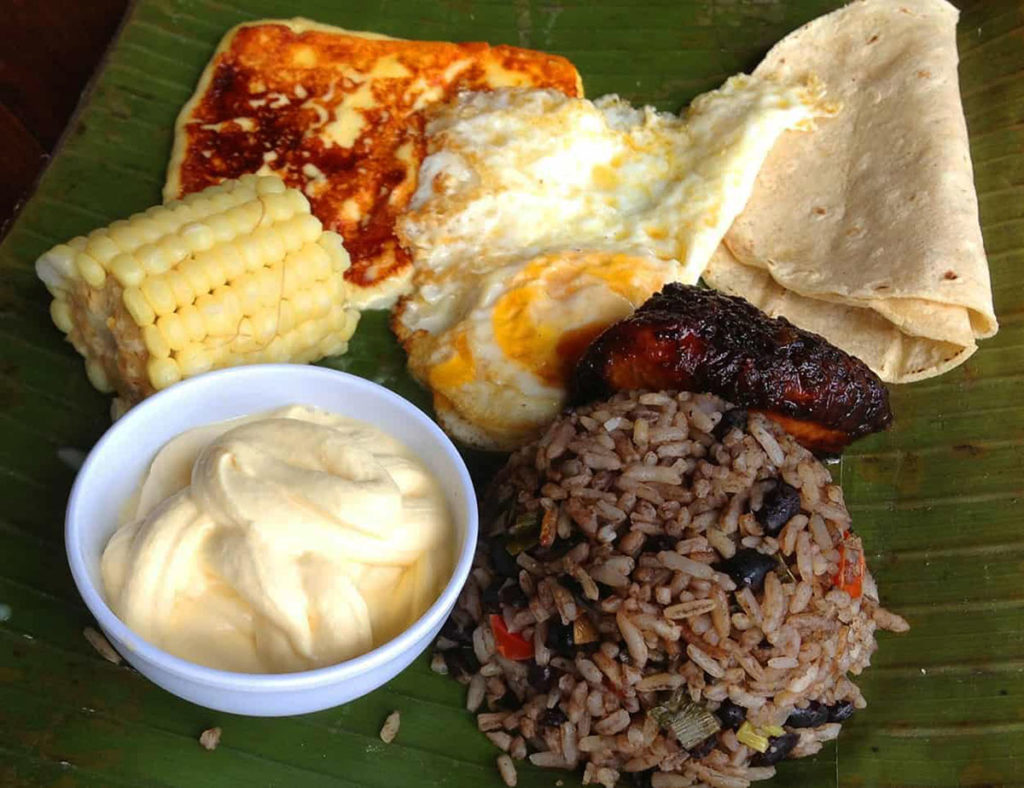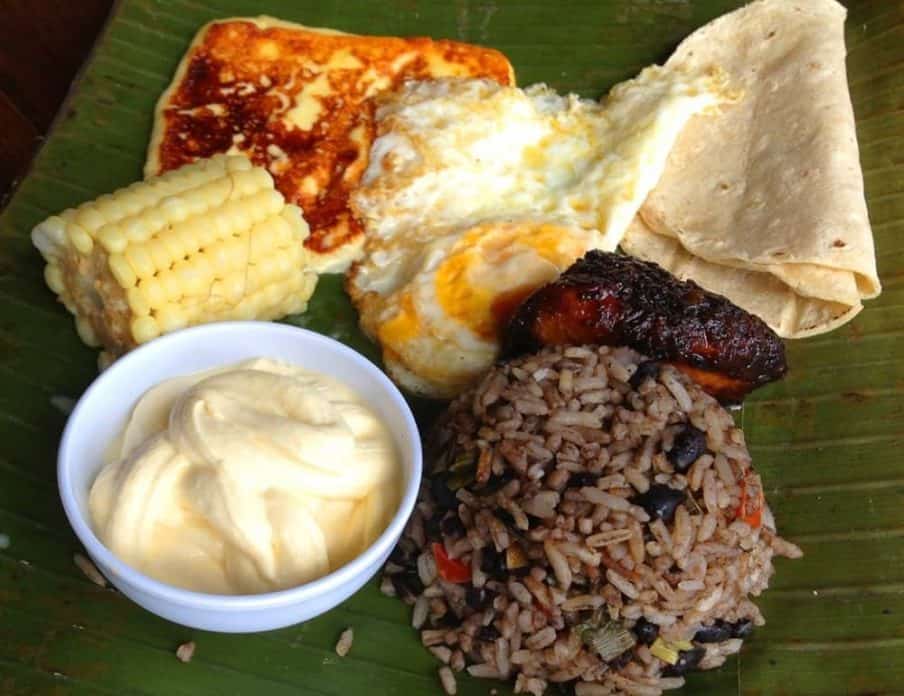
Gallo Pinto, meaning “spotted rooster” in Spanish, is a beloved staple rice and bean dish in Costa Rican cuisine with a rich history tied to the country’s cultural heritage. This simple yet flavorsome blend of rice, black beans, vegetables, and spices has become an iconic national dish adored by both locals and visitors to CostGallo Pinto: Costa Rica’s Famous Dish You Need to Try
Heading to Costa Rica? You can’t leave without tasting Gallo Pinto, the country’s iconic rice-and-beans dish that locals swear by. Its name, “spotted rooster,” comes from the speckled look of black beans mixed with rice, but the flavor—savory, spiced, and comforting—is what makes it a star. Whether you’re grabbing breakfast at a roadside soda or cooking it yourself, Gallo Pinto is your ticket to Costa Rican culture. Here’s the lowdown on this beloved dish, why it’s a must-try, and how to make it at home.
The Story of Gallo Pinto
Gallo Pinto is a cornerstone of Costa Rican cuisine, blending influences from African, Spanish, and Central American traditions. While its exact origins are debated, it likely emerged after the Spanish brought rice and the African diaspora introduced beans in the 16th-17th centuries. By the 19th century, it was a staple for working-class families, thanks to cheap, local ingredients like rice, black beans, and peppers.
The dish’s simplicity is its strength—farmers and laborers could whip it up with whatever was on hand, adding spices like cumin or local herbs for kick. Today, it’s a symbol of Costa Rican identity, served everywhere from rural homes to San José cafes. Its “Pura Vida” vibe—humble, hearty, and communal—makes it a perfect introduction to the country’s laid-back culture.
For tourists, Gallo Pinto is a cultural bridge. Eating it at a local soda (small diner) lets you share a meal with Ticos (Costa Ricans) and soak up their warm hospitality. It’s also a nod to Costa Rica’s sustainable ethos, as beans and rice are low-cost and eco-friendly staples.
Why Gallo Pinto Matters
Gallo Pinto is more than food—it’s a daily ritual. Most Ticos eat it for breakfast, often with scrambled eggs, fried plantains, or a dollop of sour cream (natilla). It’s also a side dish at lunch or dinner, paired with grilled chicken, fish, or tortillas. Its versatility makes it a go-to for families, from city apartments to rural farms.
For visitors, it’s a must-try because it captures Costa Rica’s soul. You’ll find it on every menu, from beachside shacks in Tamarindo to mountain lodges in Monteverde. It’s budget-friendly too—a plate at a soda costs $3-$6 USD, often with coffee and extras. Plus, it’s vegetarian-friendly, though some versions use pork fat, so ask if you’re meat-free.
The dish varies by region. In the Central Valley, it’s savory with black beans and subtle spices. On the Caribbean coast, like in Limón, you might taste coconut milk or hotter peppers, reflecting Afro-Caribbean flair. Trying both is a tasty way to explore Costa Rica’s diversity.
Where to Eat Gallo Pinto
The best Gallo Pinto comes from sodas, small family-run eateries serving home-style meals. In San José, try Soda Tapia for a classic plate with eggs and plantains. In Puerto Viejo, Soda Lydia adds a Caribbean twist with coconut. For upscale vibes, Restaurante Grano de Oro in San José elevates it with gourmet touches.
Join a food tour to sample Gallo Pinto alongside tamales or ceviche—companies like Carpe Chepe offer fun, guided experiences. Or visit a farmers’ market (feria) to see the fresh ingredients, like beans and cilantro, that make the dish pop. Ask for “típico” (traditional) to get the real deal, and don’t shy away from Lizano sauce, a tangy condiment that Ticos drizzle on everything.
Be ready for big portions—Costa Ricans don’t skimp. If you’re new to sodas, smile and say “Buenos días” to the staff; a little friendliness goes a long way. Most menus are in Spanish, but “Gallo Pinto con huevos” (with eggs) is an easy order.
Gallo Pinto Recipe
Want to bring Costa Rica home? This Gallo Pinto recipe is simple, authentic, and serves 4. It’s perfect for breakfast or a side dish.
Ingredients:
- 2 cups cooked white rice (day-old is best)
- 1 can (15 oz) black beans, drained and rinsed
- 1 small onion, diced
- 1 red bell pepper, diced
- 1 green bell pepper, diced
- 3 cloves garlic, minced
- 1 tsp cumin
- 1 tsp salt
- 1 tsp black pepper
- 2 tbsp olive oil
- 2 tbsp Lizano sauce (optional, for authentic flavor)
- Fresh cilantro, chopped (for garnish)
Instructions:
- Heat olive oil in a large skillet over medium heat.
- Add onion, red and green peppers, and garlic. Sauté for 5-7 minutes until soft and fragrant.
- Stir in cumin, salt, and black pepper. Cook for 1 minute.
- Add black beans and Lizano sauce (if using). Stir for 2-3 minutes to warm through.
- Add cooked rice, mixing well to combine. Cook for 5 minutes, stirring occasionally, until heated and slightly crispy.
- Taste and adjust seasoning. Garnish with cilantro.
- Serve hot with eggs, plantains, or tortillas.
Tip: Find Lizano sauce at Latin markets or online. If unavailable, swap with a dash of Worcestershire sauce.
Quick Guide for Tourists
Here’s how to enjoy Gallo Pinto on your trip:
| Activity | Details | Tips |
|---|---|---|
| Where to Eat | Sodas (e.g., Soda Tapia, Soda Lydia), restaurants, food tours | Ask for “típico”; try Lizano sauce |
| Cost | $3-$6 USD per plate at sodas; $8-$12 at upscale spots | Budget-friendly; vegetarian options |
| Regional Variations | Central Valley: savory; Caribbean: coconut or spicy | Sample both for cultural contrast |
| Dining Etiquette | Say “Buenos días”; expect big portions; menus mostly in Spanish | Smile, ask for “Gallo Pinto con huevos” |
Final Thoughts
Gallo Pinto is Costa Rica’s heart on a plate—simple, flavorful, and tied to the country’s “Pura Vida” spirit. Whether you’re digging in at a bustling soda or cooking it back home, this dish is a tasty way to connect with Tico culture. Seek it out on your trip, chat with locals over a plate, and savor the moment.

